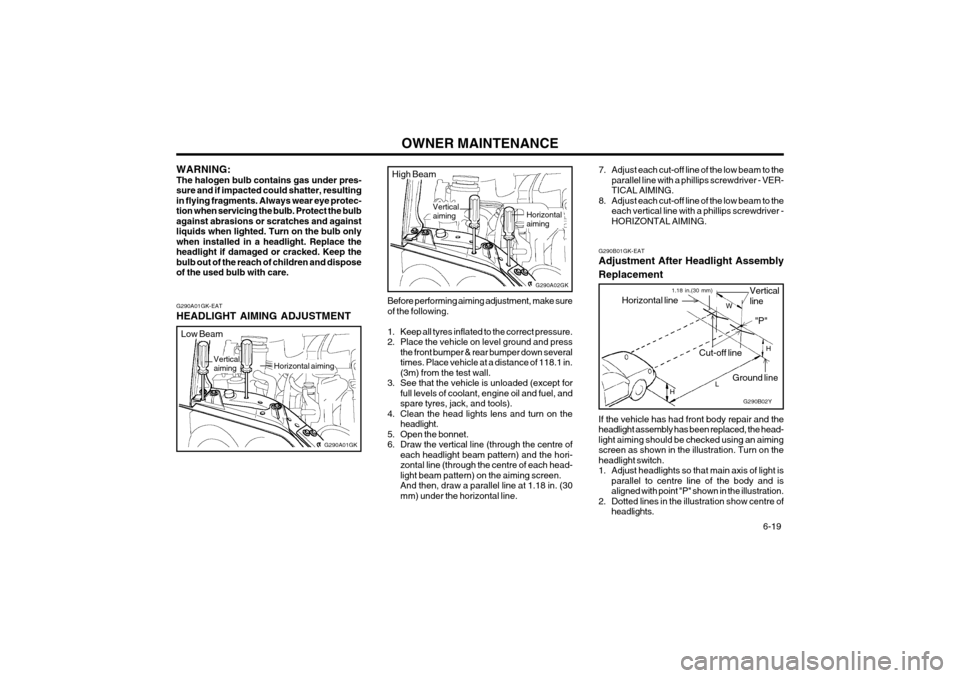coolant level Hyundai Coupe 2003 Owner's Guide
[x] Cancel search | Manufacturer: HYUNDAI, Model Year: 2003, Model line: Coupe, Model: Hyundai Coupe 2003Pages: 310, PDF Size: 2.87 MB
Page 287 of 310

OWNER MAINTENANCE
6-12 SG120A1-E BRAKE SYSTEM CHECKING CAUTION: Correct operation of the braking system is essential to the safe operation of the vehicleand therefore, any maintenance operationsother than those listed below should be en-trusted to a Hyundai dealer. SG120C2-E Brake Fluid Recommendations Only brake fluid conforming to DOT 3 or DOT 4 specifications or higher may be used in thebraking system. Care should be taken to ob-serve the instructions and precautions printedupon the container. SG120D1-E Brake Fluid LevelThe fluid level in the brake fluid reservoir should be checked periodically. The level should bebetween the "MIN" and "MAX" marks on the sideof the reservoir. If the level is at or below the"MIN" mark, fluid should be added having care-fully cleaned the area surrounding the reservoircap to ensure that dirt is not allowed to enter thesystem. It should be borne in mind that the brakefluid level will decrease slightly as the frictionlinings of the pads and shoes become worn andthat this is a normal condition.
higher mark. If additional fluid is required, thisshould be poured into the transaxle through thedipstick tube with the aid of a suitable funnel. WARNING: The cooling fan is controlled by engine cool-ant temperature and may sometimes operateeven when the engine is not running. Useextreme caution when working near the bladesof the cooling fan so that you are not injuredby a rotating fan blade. As the engine coolanttemperature decreases, the fan will automati-cally shut off. This is a normal condition.
CAUTION:The automatic transaxle unit is a precisionengineered assembly and correct operationis dependant upon the exclusion of dirt andlint from the unit. Therefore, it is imperativethat only lint free cloth (eg nylon) is used forwiping the dipstick and that the area aroundthe dipstick is thoroughly clean prior to levelchecking or adding fluid. Fluid Capacity The total fluid capacity of the transaxle unit is 7.8 litres.
HGK174-D
Fluid level should be within this range
HGK249
�Î�Î
Page 294 of 310

OWNER MAINTENANCE 6-19
G290A01GK-EAT HEADLIGHT AIMING ADJUSTMENT
Before performing aiming adjustment, make sure of the following.
1. Keep all tyres inflated to the correct pressure.
2. Place the vehicle on level ground and press
the front bumper & rear bumper down severaltimes. Place vehicle at a distance of 118.1 in.(3m) from the test wall.
3. See that the vehicle is unloaded (except for full levels of coolant, engine oil and fuel, andspare tyres, jack, and tools).
4. Clean the head lights lens and turn on the headlight.
5. Open the bonnet.
6. Draw the vertical line (through the centre of each headlight beam pattern) and the hori-zontal line (through the centre of each head-light beam pattern) on the aiming screen.And then, draw a parallel line at 1.18 in. (30mm) under the horizontal line.
WARNING:The halogen bulb contains gas under pres-sure and if impacted could shatter, resultingin flying fragments. Always wear eye protec-tion when servicing the bulb. Protect the bulbagainst abrasions or scratches and againstliquids when lighted. Turn on the bulb onlywhen installed in a headlight. Replace theheadlight if damaged or cracked. Keep thebulb out of the reach of children and disposeof the used bulb with care.
Vertical aiming
G290A01GK
Horizontal aiming
Low Beam
Vertical aiming
G290A02GK
Horizontal aiming
High Beam
7. Adjust each cut-off line of the low beam to the
parallel line with a phillips screwdriver - VER- TICAL AIMING.
8. Adjust each cut-off line of the low beam to the each vertical line with a phillips screwdriver -HORIZONTAL AIMING.
G290B01GK-EAT Adjustment After Headlight Assembly Replacement
G290B02Y
Vertical line
Cut-off line Ground line
Horizontal line
LW
H
H "P"1.18 in.(30 mm)
If the vehicle has had front body repair and the headlight assembly has been replaced, the head-light aiming should be checked using an aimingscreen as shown in the illustration. Turn on theheadlight switch.
1. Adjust headlights so that main axis of light is parallel to centre line of the body and isaligned with point "P" shown in the illustration.
2. Dotted lines in the illustration show centre of headlights.
Page 299 of 310

EMISSION CONTROL SYSTEM 7-1
SH010A1-E EMISSION CONTROL SYSTEMS (Not all models) Depending upon the market for which the vehicleis destined, the emission control system willcomprise one or more of the following emissioncontrol devices. (1) Crankcase emission control system (2) Evaporative emission control system(3) Exhaust emission control system In order that the proper functioning of the emis- sion control systems may be ensured, it isrecommended that the vehicle is inspected andmaintained by an authorized Hyundai dealer inaccordance with the maintenance schedule inthis manual.
SH000A1-E
7. EMISSION
CONTROL SYSTEM
SH010B1-E
1. CRANKCASE EMISSION CONTROL SYSTEM
The positive crankcase ventilation system is employed to prevent air pollution caused byblow-by gases being emitted from the crankcase by introducing fresh air to the crankcase throughthe air cleaner where this mixes with blow-bygases and then passes through the PCV valveinto the intake manifold from where it subse-quently enters the combustion chamber and isburned.
SH010D1-E
3. EXHAUST EMISSION CONTROL SYSTEM The exhaust emission control system is a highlyeffective system which controls exhaust emis-sion while maintaining good vehicle performance.
SH010C1-E
2. EVAPORATIVE EMISSION CONTROL SYSTEM
The Evaporative Emission Control System is designed to prevent fuel vapours from escapinginto the atmosphere through the fuel tank venti-lation system.Whilst the engine is not running, fuel vapours generated inside the fuel tank are absorbed and stored in a charcoal canister. When the engine isstarted, the vapours stored in the canister aredrawn into the induction system through thepurge control solenoid valve and are subse-quently burned.The purge control solenoid valve is controlled bythe ECU; when the engine coolant temperatureis low or the engine is idling, the purge controlvalve is closed and fuel vapours remain stored inthe canister. Under normal running conditionswhen the engine is warm, the valve opens andthe vapours are drawn into the inlet tract andsubsequently burned in the combustion cham-ber. SH020A1-E CATALYTIC CONVERTOR OPERATING PRECAUTIONS Hyundai Coupe models are fitted with catalytic convertors which require special operating con-siderations. The catalytic convertor serves tooxidize certain noxious elements of the exhaustgases leaving the engine to reduce the level ofpollutants emitted from the vehicle and, providedthat care is exercised to prevent damage, thecatalyst will operate efficiently for the life of thevehicle.It is of the utmost importance that the followinginformation is read and understood by the ve-
7
Catalytic Converter
SSA7020A
Page 308 of 310

INDEX
10-2 E EFFECTIVE BRAKING
....................................................................... 2-8
ELECTRIC COOLING FANS ........................................................... 6-17
EMISSION CONTROL SYSTEMS ..................................................... 7-1
ENGINE COMPARTMENT ................................................................. 6-1
ENGINE COOLANT CHECKING AND REPLACI NG ........................ 6-7
ENGINE COOLANT TEMPERATURE GUAGE ...............................1-30
ENGINE OIL AND FILTER REPLACEMENT .................................... 6-6
ENGINE OIL CONSUMPTION ........................................................... 6-6
ENGINE OIL REPLENISHMENT ............ ........................................... 6-5
ENGINE OIL ....................................................................................... 6-4EXTERIOR REAR VIEW MIRROR .................................................. 1-42
FFOLDING REAR SEAT .................................................................... 1-10
FRONT ASHTRAY ........................................................................... 1-38
FRONT DOOR EDGE WARNING LAMP ........................................1-45
FRONT FOG LIGHT SWITCH ......................................................... 1-44
FRONT SEAT ADJUSTMENT ........................................................... 1-7
FRONT SEAT BELT PIVOT HEIGHT ADJUSTMENT ....................1-12
FUEL ECONOMY ............................................................................... 2-3
FUEL GAUGE .................................................................................. 1-29
FUEL RECOMMENDATIONS ........... ................................................. 1-1
FUSE PANEL DESCRIPTION ......................................................... 6-22
FUSIBLE LINKS ............................................................................... 6-16G
GLOVE BOX .....................................................................................
1-41
HHATCHBACK DOOR ........................................................................ 1-46
HATCHBACK DOOR WIPER AND WASHER ................................1-36
HAZARD WARNING SYSTEM ........................................................ 1-36
HEADLIGHT BULB ........................................................................... 6-18
HEADLIGHT AIMING ADJUSTMENT ..............................................6-18
HEADLIGHT LEVELING DEVICE SYSTEM ....................................1-38
HEAD RESTRAINT ADJUSTMENT ................................................... 1-8
HEATED REAR WINDOW ......... ...................................................... 1-36
HEATING AND COO LING CONTROL ............................................ 1-51
ROTARY TYPE ................................................................. 1-52 ~ 1-56
AUTOMATIC TYPE ........................................................... 1-57 ~ 1-62
HORN ............................................................................................... 1-48
IIF THE ENGINE CANNOT BE CRANKED ........................................ 3-1
IF THE ENGINE OVERHEATS .......................................................... 3-2
IF THE ENGINE WILL NOT START .................................................. 3-1
IF THE EVENT OF A PUNCTURE .................................................... 3-3
IMMOBILIZER SYSTEM ..................................................................... 1-2INDIVIDUAL CIRCUIT FUSES ......................................................... 6-17
INSTRUMENT CLUSTER AND INDICATORS ................................1-26